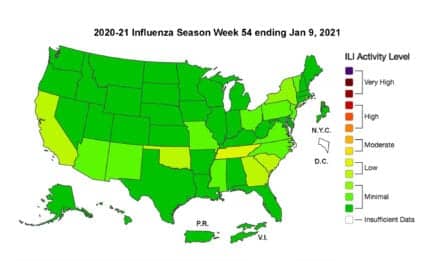Threat of Smallpox
Respiratory therapists should be able to recognize the signs and symptoms of smallpox infection so that effective control measures can be implemented in case of a bioterrorism attack.
A group of 12 office workers suddenly develop high fever, malaise, headache, and joint pains. Three of the workers also experience intense abdominal pain. A physician believes there may have been a localized infectious event and prescribes a broad-spectrum antibiotic and bed rest. The workers rest at home but get worse over the ensuing days.
About 2 weeks after the onset of symptoms, all of the office workers develop a maculopapular rash over the mouth, face, and forearms. After only a day or two, the rash becomes vesicular and spreads to the trunk and legs. The treating physician notifies the Centers for Disease Control and Prevention (CDC) that he believes the workers are suffering from a localized smallpox outbreak. CDC representatives arrive and order that the infected persons be quarantined. They take oropharyngeal and skin tissue samples for culture, which are soon determined to be positive for smallpox virus.
After another few days, the rash becomes pustular. Crusts begin to form and the general medical condition of the workers begins to decline rapidly. Despite antibiotic therapy, hydration, and supportive care, 10 of the 12 workers die. Two recover slowly. On these two workers, the scabs begin to separate, and pitted scars develop, which are most noticeable on the face.
Case Review
The above case report is fictional. There has not been a case of smallpox in the United States since 1949. However, because of the recent anthrax cases and the increasing threat of bioterrorism, there is growing concern that the few isolates of smallpox virus known to exist in several laboratories worldwide may be used to develop the virus as a bioweapon. Hence, it is important that we reacquaint ourselves with the clinical signs and symptoms and management of smallpox infection.
Smallpox (variola) is a viral disease unique to man. Knowledge of this virus has been limited because of the obvious laboratory hazards involved in the study of this biological agent. There are two different strains of smallpox virus. The most virulent strain causes variola major, which has a mortality rate of 20% to 50%.1 Variola minor (alastrim) has a mortality rate of less than 1%.1
Historical Perspective
The origin of smallpox is unknown. It has been reported to have been present in India and China for thousands of years. It was probably introduced into Europe sometime between the fifth and seventh centuries, and was frequently epidemic during the Middle Ages.
By the 18th century, smallpox was present throughout the major European cities, with epidemics occurring from time to time. All levels of society were affected. In the 18th century, the Asian practice of variolation was introduced in England. Variolation—the technique of inoculating pustular smallpox material on the arm of a susceptible individual—was the first effective immunization procedure and conferred protection much in the same fashion as vaccination. The procedure was highly controversial and practiced only sporadically. Because of the potential for acquiring a smallpox infection from the procedure, some inoculees developed the disease and died. However, the death rate from variolation was only about one tenth as high as the mortality from the naturally acquired disease. A variolated person could transmit virulent smallpox to others.
In the late 18th century, when variolation became widespread, it was common knowledge that dairymaids who had contracted an illness called cowpox would be immune to natural smallpox infection. Edward Jenner, a physician, started the practice of vaccination (vacca is the Latin word for cow) when he took material from cowpox lesions and inoculated susceptible individuals. The practice of vaccination eventually led to the control of smallpox. The last major case of variola major in the United States occurred in 1949, and due to improved vaccines and distribution, a campaign led by the World Health Organization (WHO) actualized worldwide eradication of this disease in 1977.2 In 1980, the WHO recommended that all countries cease vaccination.2
Microbiology
The smallpox virus is a complicated DNA virus that belongs to the genus Orthopoxvirus.3 The virion is characteristically a brick-shaped structure (Figure 1) with a diameter of about 200 nm.3 Three other members of this genus (monkeypox, vaccinia, and cowpox) can also infect humans, causing cutaneous lesions, but only smallpox is readily transmitted from person to person.4

Smallpox virus is relatively resistant to inactivation by chemicals (disinfectants), heat, cold, or drying. The host cells of this virus are epidermal cells, where replication of poxviruses occurs in the cytoplasm of the infected cell. To achieve this total independence from the cell nucleus, orthopoxviruses, unlike other DNA viruses, have evolved the ability to encode dozens of enzymes required for transcription and replication of the viral genome, several of which must be carried in the virion itself.
After fusion of the virion with the plasma membrane of the soon-to-be-infected cell or via endocytosis, the viral core is released into the cytoplasm. The poxvirus follows the basic replication pattern for DNA viruses; however, replication takes place in the cytoplasm and the virus provides all of the enzymes necessary for DNA replication and gene expression. Final viral maturation occurs with the production of a viral lipoprotein envelope, and the virus exits the cell through a budding process. The replication cycle is rapid, and results in early shutoff of all cell macromolecular synthesis, causing death of the cell.
Pathogenesis
Smallpox is caused by a virus that spreads from person to person in tiny droplets discharged from the mouth or the nose. (Virus particles in clothing or bedding have sometimes infected people who have not had direct contact with the patient, but such indirect infections are rare.) The usual entry of smallpox virus is through the respiratory tract, with infection of the oropharyngeal or respiratory mucosa. Secretions from the mouth and nose are the most important source of person-to-person transmission. The initial infection in the oropharynx or respiratory tract produces neither symptoms nor local lesions, and patients are not infectious until an oropharyngeal enanthem appears at the end of the primary incubation period (typically 12 to 14 days). Transmission to others is generally through coughing out of virions in oropharyngeal secretions. Patients are most infectious during the first week of rash.
The appearance of high fever and then lesions on the skin marks the end of the incubation period. Smallpox pathogenesis is a poorly understood series of events in which the virus first disseminates locally, then through the lymphatic system, and finally to the skin without affecting vital organs. About 10 to 12 days after inhaling the virus, the infected person becomes sick typically with a high fever and aching sensations resembling those of acute influenza.5 After 2 to 4 days, a maculopapular rash develops over the face, and within a day or two it spreads over the entire body. Usually the rash has a “centrifugal” distribution; it is densest on the face, arms, and legs, and less dense on the trunk. The small, red, pimple-like papules quickly become enlarged vesicles filled first with a clear serum and then, by the fifth day of the rash, with pus. The patient remains febrile throughout the evolution of the rash and customarily experiences considerable pain as the pustules grow and expand. By the tenth day, scabs begin to form, and by the third week, they fall off, leaving depigmented areas that eventually become pitted, disfiguring scars.
Smallpox is commonly confused with chickenpox, and during the first 2 to 3 days of the rash, it may be impossible to distinguish between the two. However, all smallpox lesions develop at the same pace and, on any part of the body, appear identical. Chickenpox lesions are more superficial and develop in crops. With chickenpox, scabs, vesicles, and pustules may be seen simultaneously on adjacent areas of the skin. Moreover, the rash of chickenpox is denser over the trunk (the reverse of smallpox), and chickenpox lesions are almost never found on the palms or soles.
In 5% to 10% of smallpox patients, more rapidly progressive, malignant disease develops, which is almost always fatal within 5 to 7 days.4 In such patients, the lesions are so densely confluent that the skin looks like crepe rubber; some patients exhibit bleeding into the skin and intestinal tract. Such cases are difficult to diagnose, but they are extremely infectious.
Smallpox spreads most readily during the cool, dry winter months but can be transmitted in any climate and in any part of the world. The only treatments against the disease are vaccination and patient isolation. Vaccination as late as 4 to 5 days after exposure may protect against death. Because smallpox can be transmitted only from the time of the earliest appearance of rash, early detection of cases and prompt vaccination of all contacts are critical.
Preexposure Vaccination
Before 1972, smallpox vaccination was recommended for all US children at the age of 1 year. Most states required that children be vaccinated before school entry. The only other requirement for vaccination was for military recruits and tourists visiting foreign countries. Routine vaccination in the United States ceased in 1972. The immune status of those who were vaccinated more than 30 years ago is not clear. The duration of immunity has never been satisfactorily measured. Neutralizing antibodies are believed to reflect levels of protection, but these antibodies have been shown to decline during a 5- to 10-year period.6 Hence, even people who received the recommended single-dose vaccine as children may not have lifelong immunity.
In the United States, a limited leftover supply of vaccine that was produced by Wyeth Laboratories in the 1970s is in storage. The supply is believed to be sufficient to vaccinate up to 7 million people. This vaccine is now under the control of the CDC. The development and licensure of a new vaccine are now under way to meet the potential need of a bioterrorism response.
Conclusion
Smallpox, a scourge that once killed millions and was eradicated from human reservoirs by 1980, is unfortunately once again a concern. Because the virus is known to exist in several laboratories throughout the world, the threat of a deliberate aerosol release of smallpox is real. Consequently, all clinicians, including respiratory care clinicians, should be able to recognize the signs and symptoms of smallpox infection so that effective control measures, including isolation and care of infected individuals, can be implemented quickly in the event of a bioterrorism attack.
Phyllis C. Braun, PhD, is professor, Department of Biology, Fairfield University, Fairfield, Conn, and John D. Zoidis, MD, is a contributing writer for RT Magazine.
Further Reading
Tucker JB. Scourge: The Once and Future Threat of Smallpox. New York: Atlantic Monthly Press; 2001.
References
1. Mack TM. Smallpox in Europe, 1950-1971. J Infect Dis. 1972;125:161-169.
2. World Health Organization. The Global Eradication of Smallpox: Final Report of the Global Commission for the Certification of Smallpox Eradication. Geneva, Switzerland: World Health Organization; 1980.
3. Fenner F, Wittek R, Dumbell KR. The Orthopoxviruses. San Diego: Academic Press; 1988.
4. Breman JG, Henderson DA. Poxvirus dilemmas: monkeypox, smallpox, and biological terrorism. N Engl J Med. 1998;339:556-559.
5. Esposito JJ, Massung RF. Poxvirus infections in humans. In: Murray PR, Tenover F, Baron EJ, eds. Clinical Microbiology. Washington, DC: American Society of Microbiology; 1995:1131-1138.
6. Downie AW, McCarthy K. The antibody response in man following infection with viruses of the pox group, III: antibody response in smallpox. J Hyg. 1958;56:479-487.









